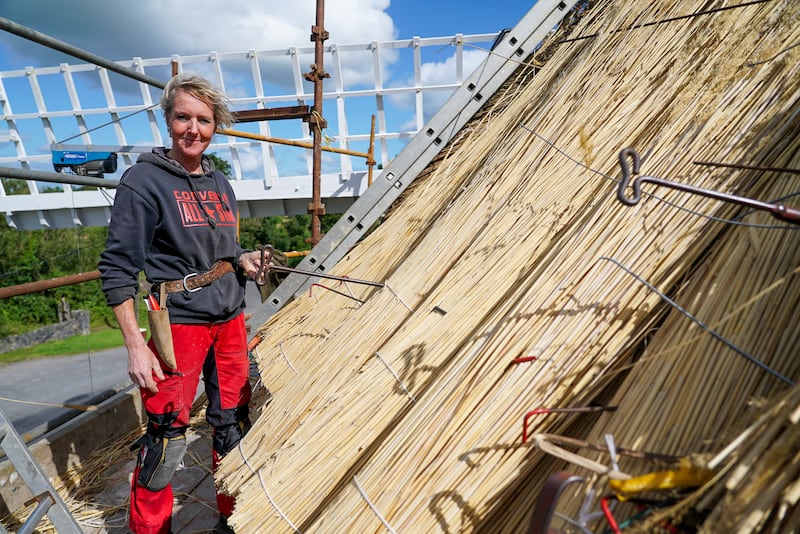I’m from the Netherlands. I always said that I would live in Ireland because, as a family, we spent all our summers here. I left home really young and when I was about 15, I was working on fishing boats in Scotland. I made my way to Northern Ireland and I hitched down to Galway.
I met three bachelor farmer brothers aged 60, 70 and 80 up the road from where I still live and, more or less, they adopted me and I adopted them. They had no close family, and they were delighted to have a young person to do all the work with them. I fell in love with them, and they fell in love with me. I lived with them for three or four years until I bought my own house.
That’s how I got into thatching. One of them used to do a bit of it, but he couldn’t get up the ladder any more, and that was the reason I was put up. He would give me instructions from below. He taught me how to do the thatching, and I was just mesmerised by it. It opened up a new world.
We used straw that was grown locally and hazel scallops that we cut locally. I was just like: ‘Wow, you can make your own roof with material that grows around you.’ That really intrigued me. That’s how it really started for me, the whole thatching thing. That’s 40 years ago now.
READ MORE
In my late 20s, I got married to a thatcher, and we worked side by side for years. When my kids were younger, I did a lot of the prep work at home – pointing and splitting scallops, which are the hazel rods you use for keeping on the thatch.
I did a thatching apprenticeship and that gave me a sort of peace. I said: ‘Okay, I’m a thatcher now, that’s what I am’
I had left school so young, I always said: ‘I’ll go to college, I’ll do a degree, get a proper job.’ But I just couldn’t be inside. Instead, I did a thatching apprenticeship and that gave me a sort of peace. I said: ‘Okay, I’m a thatcher now, that’s what I am. I don’t need to be searching.’ I’ve been full-time thatching ever since.
I have a passion for conservation and for old buildings: I think my parents instilled that in me. And my husband and I have an interest in anything old, really. There was so little conservation in the 1980s, everything disappeared so quickly. In Ireland, it’s all connected to poverty and hard times, so I know why thatched houses disappeared. People wanted a better life and they built bungalows.

That’s what I really like about thatching: to be part of trying to preserve the few buildings that are still there. I take pride in that. I like being outside, I like the connection with nature. You see the changing seasons, you hear the birds around you. I enjoy being in the middle of that. The work is very repetitive: it’s a bit like knitting a jumper. You’re constantly repeating what you are doing.
I suppose it would be tough on your hands, but you get hard skin so you are used to it. The reeds can have nasty splinters that get into your fingers or under your nails, so I wear gloves a lot now. It’s hard on your elbows if you are twisting hundreds and hundreds of scallops a day. On days where there is horrible weather, it can be quite tough to motivate yourself to stay working.
It’s very satisfactory to finish a job, because you usually make a nice finish on top and it all looks good. That gives me great satisfaction, but by the time I get to that, I’m already looking forward to my next job.
If you’re working on an old roof, you always try to figure out what’s underneath: what am I going to find, what are the problems. That always really excites me. On protected structures, you’re not allowed to take off the historic layers, you are trying to protect the integrity of the old roof, but sometimes you have a really rotten patch and you have to go down deeper.
I found a big knife in a roof in Sligo. I treasured it because it was so handy. I lost it again on another roof. So it passes on to someone else
I have come across some really interesting materials – nettles, briars, bracken, purple moor grass. People used a lot of that in the west when they had no straw. In Connemara, I came across a house where the súgán rope was pegged in with driftwood. It was really cool to see how people were creative about a lack of materials.
I have found a few treasures, too. Old bottles in the thatch – it was either an alcoholic thatcher or somebody hiding a message. I found a big knife in a roof in Sligo. I believe it belonged to the previous thatcher, and I treasured that knife because it was so handy. I lost it again on another roof. So it passes on to someone else.
I also found a sword, hidden in the scraw, which is the oldest layer of the thatch. I pulled it out and it was quite amazing to find it in there.
I really love what I do. I hope to be at it for a long time yet. I don’t think I have any other wish but to do what I’m doing.
In conversation with Joanne Hunt
If you have an interesting job or hobby that you would like to tell us about, email magazine@irishtimes.com with What I Do in the subject line.














